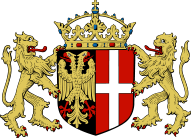The Neuss coat-of-arms
The Neuss coat of arms is historically one of the most important. It is also the symbol for a turbulent century-long history.
The city's oldest coat of arms, which can be traced back to as early as 1217, showed a white cross on a red background.
After having successfully defended the siege by Charles the Bold in 1475, Emperor Frederick III awarded numerous rights to the city and its citizens. In addition to the right to seal using red wax, Neuss was also granted a new coat of arms, a privilege compared to most other German cities. Unlike Cologne, Neuss was not made an imperial city, but was, however, permitted to bear the symbols of the empire, namely the double-headed eagle in a black shield, crowned by the imperial crown.
After 1550, the old and the new coat of arms were united in one shield. Since that time, the heraldic description of the coat of arms has been as follows: The shield split by black and gold, in front (or right) there is a double-headed eagle, in the back (or left) a silver cross. The shield is covered by the gold imperial crown and held by two gold lions.
The lions as holders of the shield are an additional element, and do not form part of the actual coat of arms. They have, however, become established since their initial appearance around 1637/38.

